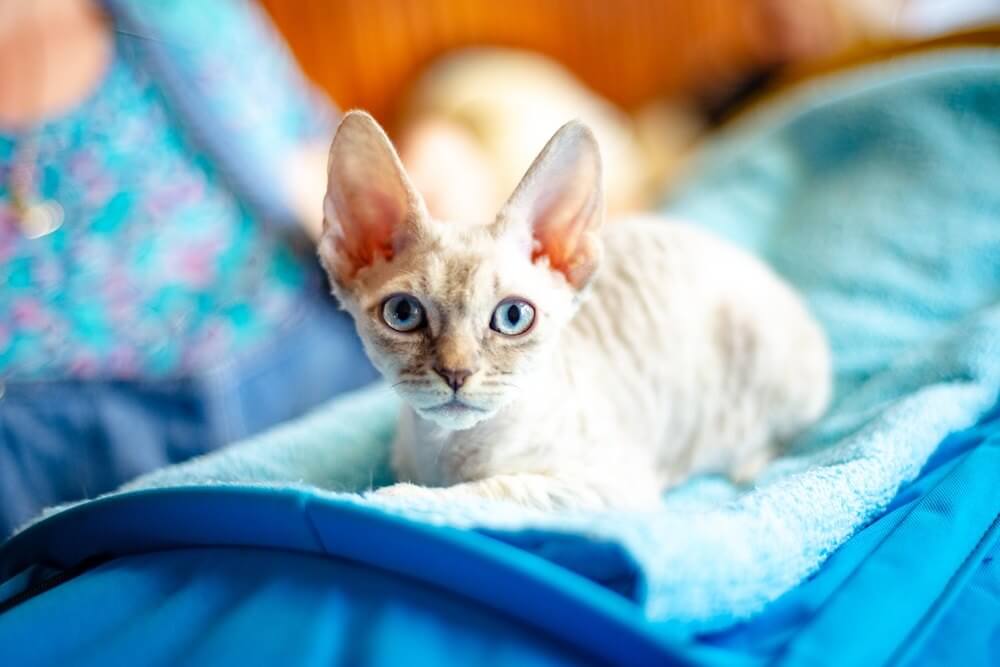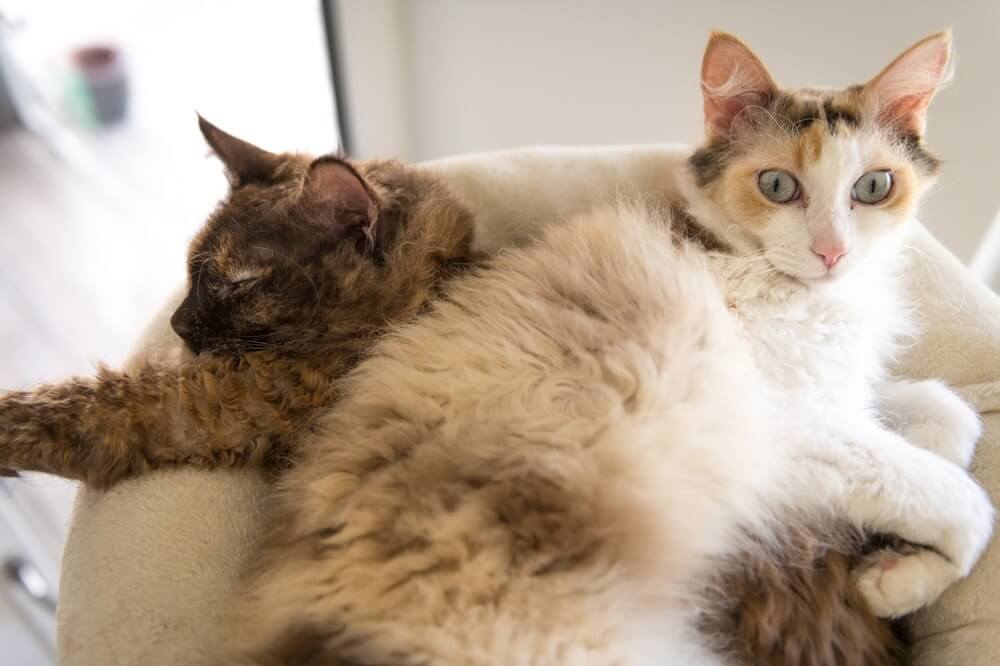
Sel_Sanders / Shutterstock.com
If you’re looking for cute cat breeds, the curly-haired cats are some of the most adorable cats around! The Cat Fanciers’ Association (CFA) and The International Cat Association (TICA) recognize four curly-haired cat breeds: the Cornish Rex, Devon Rex, LaPerm, and Selkirk Rex. A fifth curly breed, the German Rex, is only recognized by the International Cat Federation (FÊdÊration Internationale FÊline, or FIFe).
What Makes Curly Cat Fur?
“What I find fascinating is that all four of our curly coated breeds have a different genetic mutation that makes their hair curly,” said Teresa Keiger, a CFA allbreed judge. “These are all spontaneous gene mutations—Mother Nature gave them to us—and we can trace each breed’s history back to the original cat. Breeders worked with each of the foundation cats to create what would become the breed as we know today.”
Curly-haired cat breeds are among the most unique in the feline kingdom. A cat with curly hair stands out from the crowd since most cats have straight or wavy hair. Of all the breeds of cats, just a handful have curly hair, making them both rare and desirable.
“I think people are taken with the unique curly coats of these breeds,” Keiger said. “Visually, they are all very appealing. Plus, they really do not feel like any other breeds’ coats.” Meet these five cute cat breeds with curly hair.
#1 Cornish Rex

Fedir Shulenok / Shutterstock.com
The Cornish Rex has a short “rexed” coat (tight or loose Marcel waves of hair that lie close to the skin). The coat is soft and silky and feels like velvet. All Cornish Rex cats can trace their lineage back to a single curly-haired kitten born in a litter in Cornwall, England, in 1950. This kitten, named Kallibunker (Kalli for short), was used in a breeding program and her offspring became the foundation cat of the breed.
“Cornish Rex have probably the most unique body of any of our breeds, resembling that of a Greyhound with the long legs and tucked-up waist,” Keiger said. “I find their coat pattern fascinating as it is row after row of soft curls.”
The Cornish Rex is social, active, and curious. Described as kitten-like well into adulthood, Cornish Rex want to play and be a part of the action no matter what is going on. They get along great with kids and other pets, making them a wonderful family cat.
#2 Devon Rex

Veera / Shutterstock.com
The Devon Rex has a short, wavy coat that is slightly longer and denser than the fine coat of the Cornish Rex. Devons have a uniquely short “pixie” face, created by the breed’s large wide-set eyes, short muzzle, full cheekbones, and large low-set ears. Devon Rex cats also have adorable curly whiskers.
The Devon Rex breed came to be when a curly-haired stray tom cat mated with a female stray taken in by a woman in Devon, England. One male kitten in the litter inherited his father’s unique curly coat, and that kitten, named Kirlee, became the foundation of the Devon Rex breed.
“Devon Rex are very owner-oriented, and insist on being with their people,” Keiger said. “And who can resist a cat that looks like a pixie?”
These affectionate cats are playful and energetic. They can be mischievous and even a touch naughty. Most owners just laugh at their antics—it’s hard to be upset with that adorable little face!
#3 German Rex

Dizfoto / Shutterstock.com
The German Rex is a very rare breed that originated in Germany. After World War II, a stray female cat with a unique wavy coat was rescued from the streets. This cat, named Lammchen, was the beginning of a new rex cat breed dubbed the German Rex. The breed is not recognized by any North American breed registries, but it is recognized internationally by the International Cat Federation (FIFe).
The German Rex’s coat is short, wavy, and silky, with a feel like velvet. These medium-sized cats are playful and energetic. They are known for being friendly and affectionate, bonding closely with their human family.
#4 LaPerm

Linn Currie / Shutterstock.com
The LaPerm breed originated when a strange bald kitten was born in a litter of barn cats in Oregon in 1982. The kitten later grew a soft, curly coat. Over the next decade, more bald-to-curly kittens popped up in the barn cats’ litters, and eventually, the farm’s owner decided to breed them in earnest, perpetuating the curly hair gene.
The LaPerm’s soft coat can be long, short, wavy, or curly. It might look like a lot to deal with, but the coat is surprisingly easy to groom, requiring brushing a few times a week. The LaPerm is sweet and loving and bonds closely with their humans. “LaPerms are rather rare in the U.S., unfortunately,” Keiger said. “Their soft, springy coat is wonderful to touch, and they are very people-oriented.”
#5 Selkirk Rex

The Selkirk Rex is famous for plush, curly hair that has earned her the nickname “the cat in sheep’s clothing.” Jilin Su / Shutterstock.com
If you dream of owning a long-haired cat with curly hair, look no further than the Selkirk Rex! This breed’s curly locks also come in a shorthaired variety if you prefer. The Selkirk Rex breed traces its roots back to a stray curly-haired cat adopted by a Persian cat breeder in Montana. This cat, named Miss DePesto of Noface, was bred to a Persian cat and a new breed was born.
“Selkirk Rex have that incredibly dense coat, so their curly coats are also plush,” Keiger said. “I just want to continually run my hands through them! And the shorthair Selkirk Rex reminds me of a lamb.”
Selkirk Rex cats are laid-back, very loving, cuddly, and playful. Everyone who comes to visit will want to touch their intriguing coats, and the Selkirk won’t mind one bit.
Caring for Curly-Haired Cats
A cat with curly hair has different grooming requirements depending on whether the coat is short or long. Shorthaired curly-coated cats like the Cornish Rex, Devon Rex, and German Rex need very little grooming since the velvety hair is very short and lies close to the skin.
“The Cornish Rex really requires no combing at all,” Keiger said. “Just a bath when needed. Same with the Devon Rex—gently comb, and then wash when necessary. Towel dry them as blow-drying will blow out all the curls!”
Longhaired curly-coated cats like the LaPerm and Selkirk Rex need more grooming. For the LaPerm, that’s brushing or combing two or three times a week to keep the coat tangle-free and prevent matting. The Selkirk needs less brushing—weekly is usually sufficient.
“Their curls can be a bit fragile, so do use care when combing them out,” Keiger said. “You don’t want to pull out extra fur. Preferably, use a wide-toothed comb.”
Where To Find a Curly-Haired Cat
Curly-haired cat breeds are rare, so it might take a little time to find one. If you are up for the challenge, however, these unique cats are worth the wait!
The first thing to do is to set up your adoption search alerts. Yes, it’s possible to adopt a curly-haired cat through a local animal shelter or a private rescue group. It’s simple and fun to use a tool like Petfinder or Adopt a Pet to set up alerts for the curly cat breeds you’re interested in.
After trying adoption, you can also search for a reputable cat breeder. Before ever contacting a breeder, do thorough research to ensure they are responsible. Ethical breeders provide suitable care and living conditions for their adult-breeding cats and kittens. They will test their adult cats for genetic diseases before breeding them to reduce the chances of passing on health issues to kittens.
“I encourage anyone looking for any pedigreed cat to attend a local cat show,” Keiger said. “There they can see examples of the breed ‘in the fur’ and talk with the breeder or exhibitor in person. While not all breeders advertise, another place to look is on CFA’s Find a Breeder page. Official breed clubs often have breeder listings as well.”




This article is a delightful read for anyone interested in unique feline breeds! The detailed insights into curly-haired cats like the Cornish Rex, Devon Rex, LaPerm, and Selkirk Rex are both informative and engaging. Learning about the genetic mutations that lead to their distinctive coats adds a fascinating layer to understanding these breeds. Thanks for shedding light on these charming curly-coated companions!